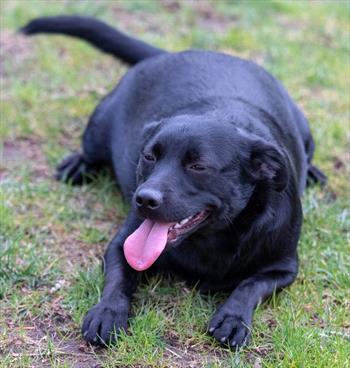Obese black Lab mix on grass

Ask any general practice small animal veterinarian what their most dreaded surgery is and many will say it's the obese, large-breed dog spay. Even veterinarians who grumble about the local low-cost spay/neuter place taking their business, are secretly happy to turf these spays to those colleagues. Why?
For soooo many reasons.
To begin with, there is the pre-anesthetic examination. Large-breed and giant-breed dogs can be harder to work with simply because they are bigger. If a chihuahua doesn't want to stand during the exam, it's easy to lift them up and hold them in a standing position. If a St. Bernard decides they don't want to stand for an examination, it ain't happening. Add to either one of those dogs an excess of pounds and it is that much harder.
It is also more difficult to examine an obese dog of any breed. The excess weight can make feeling their abdominal organs difficult to impossible, so it is harder to say whether or not everything feels normal. When listening to the heart, the extra weight may muffle heart and lung sounds. Additionally, obese dogs pant more. This extra noise makes listening to the heart and lungs more challenging.
Then there's the anesthesia. Extra body fat can change how anesthetic drugs are absorbed and metabolized, which makes their use more unpredictable. It can be difficult to give drugs into muscles if there is a thick layer of fatty tissue over them. (Drugs injected into muscles take effect quickly; drugs in fat just sit there a long time.) An obese animal cannot breathe as well as one of healthy weight, all else being equal. That increases the risk of anesthesia when the lungs do not inflate as well as they should.
Once the dog is under anesthesia and prepped for surgery, they must be moved to the surgery table. The larger the dog - for whatever reason - the more difficult it is to move them. It can take multiple people to get the job done. Strained backs may ensue.
In a traditional approach to a spay in the U.S., after making the incision through the skin, the veterinarian must find and cut the linea alba, the place where the surgeon wants to make the entrance into the abdomen itself. It is the connective tissue where the muscles of the abdomen come together, where a seam would be between the right and left halves of the abdominal wall. (If you've seen either Top Gun movie, imagine the line that runs up and down the abdomen of the guys during the beach scenes. That's where the linea alba is located.) An incision here will make for less bleeding, less pain to the patient, and an easier surgery. When there is a great deal of fatty tissue between the skin and the linea alba, it is much harder to find and therefore, it is more likely the incision won't be quite where the surgeon intended it to be. It's not that it makes the surgery impossible, just more difficult than one hopes.
Also, there will be more fatty tissue in the abdomen in obese dogs. Like with the linea alba, the fatty tissue here can disguise the look of normal organs and make them more difficult to find. It's like the difference between driving a familiar road on a sunny day and a really foggy day. On the foggy day, you still have an idea of where the twists and turns are, but you can't see them until you're on top of them, making an accident more likely. And like driving on a foggy day instead of a sunny day, the surgery itself is often slower and takes longer, which means more time under anesthesia for the pet.
Perhaps the biggest concern to many veterinarians, fat makes things slippery. It's what keeps meat from sticking in a pan when we sauté it. In a car, oil (liquid fat if you will) keeps parts greased so they slide around with each other instead of gumming up. While this is good in a car, it is not good for a surgeon trying to hold an instrument or tighten a knot. These are things we do not want to have slip.
Finally, the extra fat also means that recovery after surgery will be harder for the pet because of the extra weight. It's like the difference between going for a walk and going for a walk with bricks in your pockets. The extra weight makes it harder. It's also more difficult for the pet to breathe deeply since the chest can't expand as well which can delay recovery from anesthesia. The extra weight may also pull on sutures more which can be uncomfortable.
For all of these reasons, it's important to keep our dogs, cats and other pets in good weight. It's better for their health and, should they need surgery for any reason, it makes it much easier on the surgeon and your pet. And if that isn't convincing enough, these added difficulties are also the reason some veterinarians charge more for obese spays.